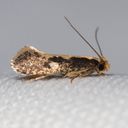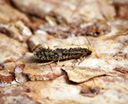Hodges#0415
Monopis crocicapitella
Classification
- Phylum: Arthropoda
- Subphylum: Hexapoda
- Class: Insecta
- Order: Lepidoptera
- Superfamily: Tineoidea
- Family: Tineidae
- Subfamily: Tineinae
- Genus: Monopis
- Species: crocicapitella
Pronunciation
How to pronounce Monopis crocicapitella: /mɒˈnəʊ.pɪs ˌkrɒ.sɪ.kæ.pɪˈtɛl.ə/
These audio files are automatically generated. While they are not always 100% accurate, they are a good starting point.
Images






Summary
Monopis crocicapitella, also known as the pale-backed clothes moth, is a destructive moth of the Tineidae family described in 1859, primarily found in the northern hemisphere and particularly damaging to fabric due to its larval feeding habits.
Physical Characteristics
Forewing length averages 4-6 mm, but can be up to 8 mm. Head: Yellow, long haired (scaled). Palpi long, folded, yellowish, dark on underside. Antenna: Long; more than half as long as wings. Simple, dark. Thorax: Yellow with dark brown side edges. Underside pale yellowish, speckled with dark. Wings: Long, narrow, brown flecked with yellow with an uneven but wide yellow border along lower edge, semi-hyaline discal spot mid wing, fringe brown with longer fringe at wing tip half brown half yellow. Hindwings brownish-gray. Legs: Smooth, brown with yellow flecks and tips. Abdomen: Pale yellowish, flecked with brown.
Identification Tips
Identifiable by its long narrow wings with a yellow border along the lower edge and brownish-gray hindwings.
Habitat
Found associated with debris, fungus, rotting vegetation, and stored grain products. Often found in caves associated with bird nests and bats.
Distribution
Found throughout much of the northern hemisphere with a nearly cosmopolitan distribution. Particularly noted in the eastern United States and western Europe where adults are observed from June to October.
Diet
Larvae feed on fabric and clothing, making the species particularly destructive of these materials.
Life Cycle
Details on the life cycle are not extensively covered in the available data, but typical lepidopteran life cycles apply.
Reproduction
Information on reproduction is not detailed, but lepidopteran generally reproduce through laying eggs, which develop into larvae (caterpillars), pupae, and then adult moths.
Predators
Specific predators are not mentioned; however, as a moth, it may have various natural insectivorous predators.
Ecosystem Role
Potentially acts as a decomposer in its habitat, feeding on decaying organic matter, though specific roles are not detailed.
Economic Impact
Destructive of fabric and clothing, particularly in infested homes and warehouses, leading to economic concern for textile preservation.
Tags
- Moth
- Pale-backed clothes moth
- Tineidae
- Insect
- Lepidoptera